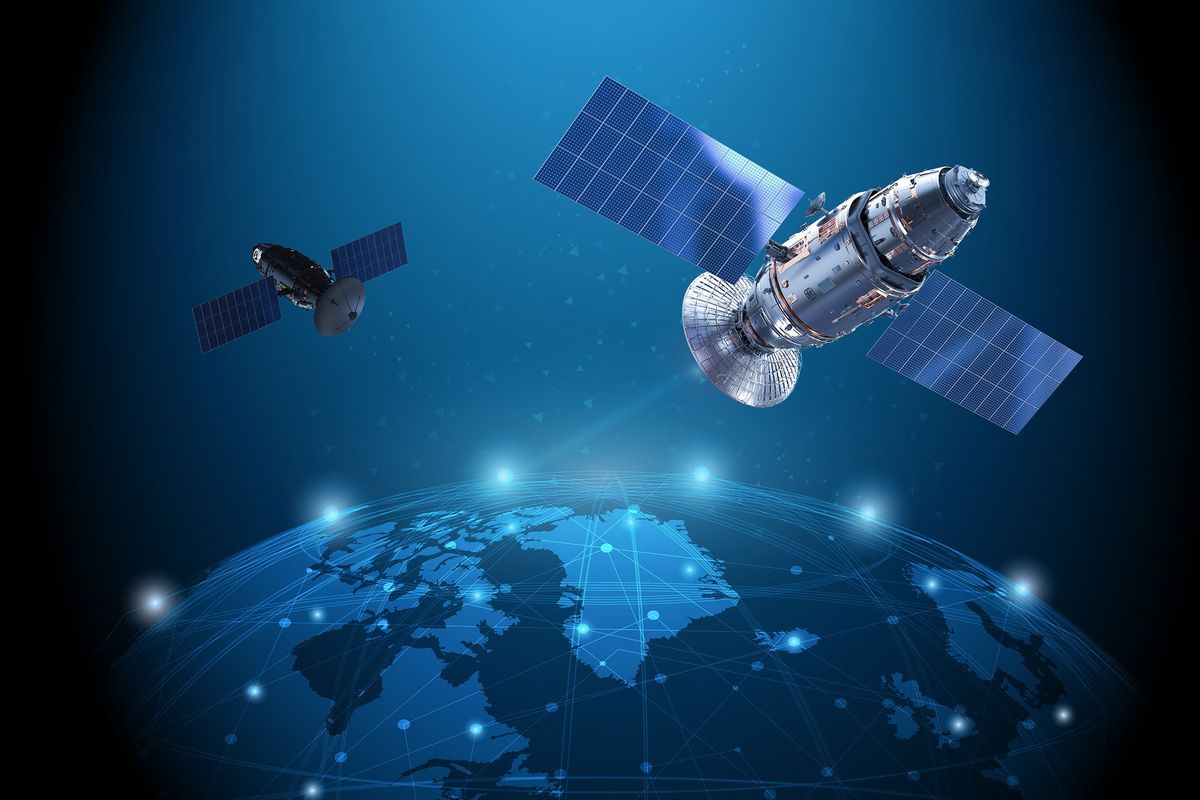When is the Starlink IPO Date and Can You Invest?
The idea of an impending IPO for Starlink has investors understandably excited. What exactly is Starlink, and is an IPO on the horizon?

There's been a great deal of speculation surrounding a potential Starlink initial public offering (IPO), and the idea of an impending Starlink stock release date has investors excited.
Elon Musk's satellite internet business been referred to by many as the future of global connectivity, offering low latency and high speed in even the most remote locations. The company controls roughly 7,000 satellites and recently surpassed over 4 million subscribers.
One reason for this interest is Musk's reputation in the investment space, as he has been involved in multiple highly successful and high-profile tech companies. Starlink itself is an offshoot of one of his other companies, SpaceX.
Even without Musk's involvement, Starlink has immense market potential. A lack of connectivity is one of the most significant bugbears facing the proliferation of technology like autonomous vehicles and the internet of things. By removing this restriction, Starlink could cultivate a flood of invention and innovation and allow edge computing to thrive.
The company's satellites have been deployed in countries around the world in recent years. In June 2023, parent company SpaceX was awarded a contract by the Pentagon in the US to provide internet terminals for use in Ukraine. A few months later, following the launch of its war on Hamas, Israel entered into talks with SpaceX to secure the use of Starlink satellites as a backup communications system.
Additionally, the company launched a US$90 million deal with Mexico in November 2023 to provide free internet to remote regions, and Telstra Group (ASX:TLS,OTC Pink:TTRAF) became one of the first service providers to offer Starlink connectivity to rural Australians in July of that year.
More recently, the company has been making significant inroads into African countries, including Zimbabwe, Niger, Liberia, and Musk's native country of South Africa.
In September 2024, Starlink inked a contract with United Airlines to provide in-flight wifi. A few months later, Starlink secured a deal with the Canadian province of Ontario to bring high-speed satellite internet access to homes and businesses in rural, remote and northern communities beginning in June 2025.
Will Starlink go public? Although a Starlink IPO has yet to be officially announced, there has been a great deal of speculation, and some experts have suggested that the occasion may be closer than many realize. That speculation has increased with US President Donald Trump's return to the White House, and the possibility of more lucrative contracts for the satellite technology company. With that in mind, those considering a Starlink investment must ensure they understand the company and its technology as soon as possible.
In this article
What is satellite internet?
A satellite internet connection transmits and receives data via a network of near-Earth satellites. Though this technology isn't new, it has evolved considerably over the past several years. At the time of its inception, it was generally only used by subscribers in remote areas who had few other options for connectivity.
The history of satellite internet traces back to 1962, with the world's first commercial communication satellite. Known as Telstar 1, the satellite was launched by NASA in response to Russia's successful launch of the satellite Sputnik 1. It had a short life, however; Telstar launched one day after high-altitude nuclear weapons testing, and radiation from the tests damaged electronics on the satellite. It was only operational for seven months before it was rendered inoperable.
Interestingly, the idea of transmitting information via satellite wasn't new at the time of Telstar's launch. Decades earlier, astronautics theorist Herman Potočnik first proposed the concept of geostationary orbital satellites in his 1929 book "Das Problem der Befahrung des Weltraums: der Raketen-Motor," which translates to "The Problem with Space Travel: the Rocket Motor." Renowned futurist Arthur C. Clarke would later cite Potočnik's work in a 1945 paper envisioning satellite communication.
The first real use of satellite internet would not occur until the late 20th century via the Teledisc project, funded by Microsoft (NASDAQ:MSFT). First proposed in 1994, Teledisc planned to establish a network of low-orbit broadband satellites. Unfortunately, the project was rendered defunct in 2002 shortly after the failure of two similar ventures, Iridium and Globalstar.
One year later, in 2003, French satellite operator Eutelsat became the first company in the world to launch a successful satellite internet project. Since then, multiple service providers and telecommunications companies have dabbled in satellite connectivity. However, it has largely lagged behind its technological peers, primarily only seeing use in particularly isolated regions.
To explain why, we need to first explain the different types of internet. The two most common are land-based connections and cellular or mobile connections.
Landline internet uses telephone lines, coaxial cables or dedicated fiber-optic cables to send and receive data from a modem or router. This device then serves as an access point, allowing everything from computers to smart home appliances to connect to the internet. Mobile internet, meanwhile, leverages nearby cell phone towers to beam data directly to and from connected devices.
Traditional satellite internet is something of a fusion between mobile and landline, albeit over a vastly larger distance. It leverages a satellite dish connected to two modems. One modem is used for sending data and the other for receiving.
Historically, speed and capacity represent the two most significant drawbacks to satellite internet. Most satellite internet service providers only support speeds between 25 and 300 megabits per second (mbps). By contrast, landline fiber internet is capable of speeds up to 5 gigabits per second (gbps). Satellite internet also tends to be far costlier than a comparable landline connection, with higher latency and lower caps on data usage. It may also suffer from issues with reliability. Lastly, satellite internet may suffer from interference due to factors such as terrain or canopy coverage.
That brings us around to what makes Starlink exciting. Although not yet competitive with landline internet in terms of cost, the company offers considerably higher data caps and speeds than any other provider on the market — up to 500 mbps with a 1 terabyte cap. Starlink's low-orbit satellites are also less vulnerable to geographic interference while offering more consistent and reliable coverage.
Does Starlink have an IPO date?
At the time of this writing, Starlink is not publicly traded, and there is no concrete date for a Starlink IPO. Hints of a possible Starlink IPO originally came from several tweets made by Musk in 2021.
"Once we can predict cash flow reasonably well, Starlink will IPO," he explained at the time. "(It will be) at least a few years before Starlink revenue is reasonably predictable. Going public sooner than that would be very painful."
Musk added later that year that Starlink's parent company SpaceX "needs to pass through a deep chasm of negative cashflow over the next year or so to make Starlink financially viable."
At the time, Musk said a Starlink IPO wasn't likely until at least 2025 or later.
It's no surprise then that market watchers’ eyebrows rose when listening to SpaceX President and Chief Operating Officer Gwynne Shotwell speak at the February 2023 Commercial Space Transportation Conference. While discussing a planned testing milestone for SpaceX's rockets, Shotwell claimed that 2023 was the year Starlink would make money.
She added that the company had a cashflow-positive quarter in 2022. There was also SpaceX's reported revenue for 2022 — just over US$3.3 billion, US$1 billion of which originated from Starlink.
In early November 2023, Musk reported that Starlink had once again “achieved breakeven cashflow."
Shortly after, an anonymous source told Bloomberg that a Starlink IPO could be on the table for 2024. But Musk quickly fired back in a post on X that the report was “false.”
It seems fairly clear based on Musk's comments that we shouldn't expect a Starlink IPO anytime soon. So why is there so much speculation that one is just around the corner?
Well, for one thing Starlink sales dominated SpaceX’s 2023 revenues, meaning the company made more money as an internet provider than as a space rocket company. Starlink revenues topped a massive US$4.2 billion that year, compared to US$3.5 billion for the firm's core rocket launch business.
Of course, these figures should be taken with a very large grain of salt. As is too often the case in technology investing, there is no shortage of hype surrounding Starlink, much of it drummed up by Musk himself. An April 2024 BNN Bloomberg article points out that even with all that revenue, Starlink “is still burning through more cash than it brings in.” Based on anonymous inside sources, Starlink accounting is “more of an art than a science."
Even if those numbers are inflated, the company does show promise, and analysts are still optimistic that a Starlink IPO is on the horizon. Justus Parmar, founder and CEO of venture capital firm Fortuna Investments, told Reuters he’s eyeing 2025 or 2026. “(Musk’s) waiting for a level of stability or predictability in revenue,” he said. Once the IPO is official, Parmar believes it will “be an extremely strong catalyst for everything space related.”
How can you get exposure before the Starlink IPO date?
While it's impossible to invest directly in Starlink, you may be able to get a head start by investing in Tesla (NASDAQ:TSLA), as Musk stated he'll "do his best" to give preference to long-term Tesla shareholders. Additionally, there are platforms such as Hiive that enable accredited investors to purchase shares of pre-IPO companies, including SpaceX.
Fortunately, you have several options if you simply want to invest in satellite internet and aren't particularly attached to the idea of Starlink. In spite of their failed efforts in the early 2000s, both Iridium Communications (NASDAQ:IRDM) and Globalstar (NYSEAMERICAN:GSAT) are currently going strong. Globalstar's performance is especially promising, as the company's share price has increased in value by almost 300 percent over the past five years as of mid-January 2025.
EchoStar (NASDAQ:SATS) is another satellite provider that's performed strongly in recent years. Other potential satellite internet investments include ViaSat (NASDAQ:VSAT) and Gilat Satellite Networks (NASDAQ:GILT).
As with any investment, it's important to do your research and speak to an accredited brokerage or investment advisor before you commit any capital.
Investor takeaway
From an investment perspective, Starlink displays incredible promise. The company's ties to Musk, a man with an established track record of successful technology startups, has generated considerable interest out of the gate. Yet even ignoring the connection to Musk, Starlink has a massive potential addressable market thanks to ongoing demand for better connectivity and a relative dearth of viable options for edge computing.
Trends such as distributed work and the proliferation of internet of things devices will only further drive this demand.
With that said, it's best to exercise a degree of restraint where Starlink is concerned. Although the company will very likely be a sound investment once it or SpaceX goes public, there is currently a great deal of exaggerated hype and speculation surrounding it. Anyone who chooses to add Starlink shares to their portfolio if the company does go public should first ensure they understand what to expect — something they cannot do by listening to hype alone.
This is an updated version of an article first published by the Investing News Network in 2023.
Don't forget to follow us @INN_Technology for real-time news updates!
Securities Disclosure: I, Melissa Pistilli, hold no direct investment interest in any company mentioned in this article.

